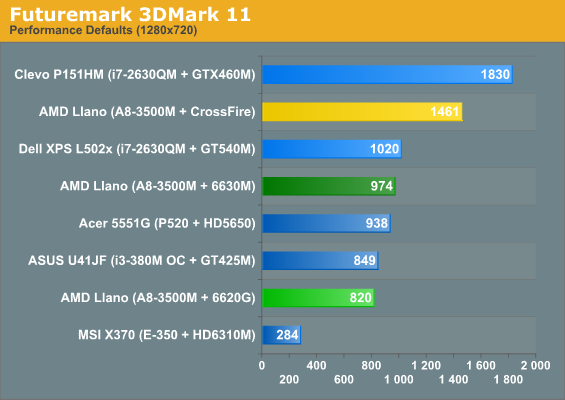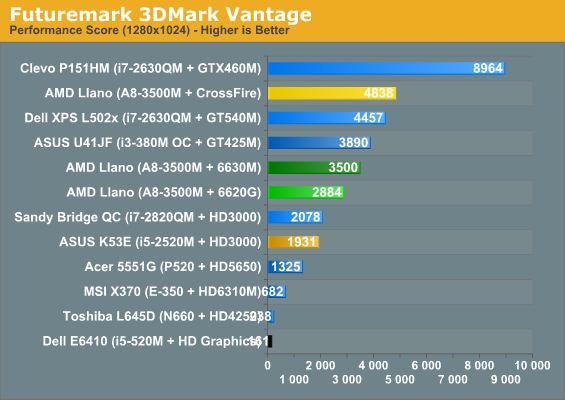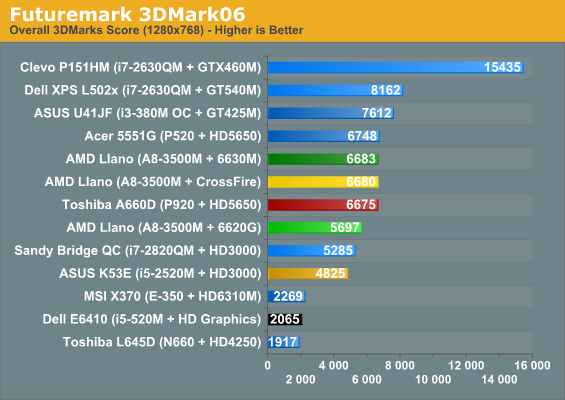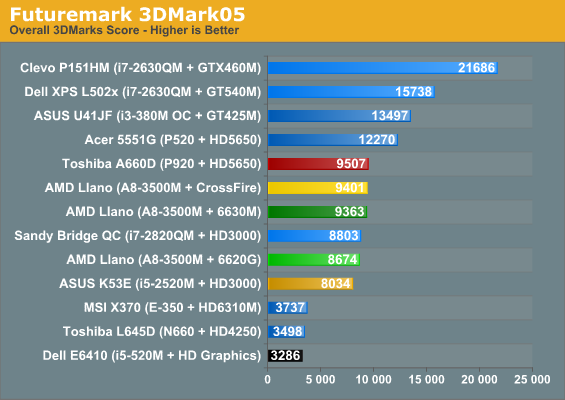The AMD Llano Notebook Review: Competing in the Mobile Market
by Jarred Walton & Anand Lal Shimpi on June 14, 2011 12:01 AM ESTFusion GPUs: A Long-Awaited Upgrade to IGPs Everywhere
During our conversations with AMD, at one point they mentioned that they prefer not to use the term “IGP” anymore since they consider it a derogatory term. I asked what we should call Llano’s graphics and they said AMD officially refers to it as the “Fusion GPU” (fGPU), so that's what we'll use going forward. Regardless of what we call it, though, there’s no doubt that the 6620G fGPU is a dramatic upgrade to the old HD 4250; in fact, the 6620G should also boast significantly better performance than Intel’s HD 3000…provided the CPU core doesn’t become a bottleneck. Let’s start with 3DMark comparisons to see just where Llano falls. Again, we have the 6620G and 6630M Llano setups tested, but now we’re adding CrossFire to the mix.






I’m including all of the 3DMark iterations to provide a broad view of graphics potential. The latest 3DMark11 release seems to be almost purely GPU-limited, but of course it requires DX11 support and thus many of the other laptops (including Intel’s IGP) fail to run it. 3DMark Vantage’s Performance defaults are about as demanding, and Llano comes out 40-50% ahead of Sandy Bridge’s HD 3000. Of course, Arrandale completely falls on its face in the Performance test, generating a result of just 161, but AMD’s old HD 4250 is only marginally better with a score of 238. Remove some of the demands with the Vantage Entry-Level preset and Sandy Bridge starts to close the gap, with the quad-core 2820QM actually coming out ahead of Llano. Things that make you go hmm….
Things don’t get any better when we look at Asymmetrical CrossFire (ACF) from Llano. 3DMark11 comes in a whopping 50% faster than the 6630M dGPU, or 78% faster than the fGPU. If that performance boost showed up in our games, things would be great, but unfortunately it doesn’t. AMD informed us just yesterday that only DX10 or DX11 games and applications will even work with ACF, so perhaps that explains why we see little to no benefit in 3DMark03/05/06. The Vantage Performance preset shows a respectable 38% increase vs. the dGPU and 68% over the fGPU, but on Entry-Level it’s only 11-14% faster, and in 3DMark03 the dGPU actually scored lower than the fGPU.
If we were to stop our analysis of graphics performance right now, I suspect there would be a lot of confusion. Llano’s fGPU is anywhere from being equal to HD 3000 to 50% faster; Asymmetrical CrossFire is either a boon or a bust. So which is it? This is why we only place a minor emphasis on 3DMarks; let’s get to some actual gaming benchmarks.










177 Comments
View All Comments
ionave - Thursday, June 16, 2011 - link
I'm honestly sick of the fact I can't play TF2 on high settings on my laptop AND I cannot find an affordable computer to do so while I'm not paying attention during class. Several people I know feel the same way.krumme - Tuesday, June 14, 2011 - link
The GPU performance hits dues to the shares bus is very low. Getting NV 540 /ati 5650 performance is far better than most expected.Battery life is simply amazing. Far better than expected.
The OEM is standing at a very long line for this.
GeorgeH - Tuesday, June 14, 2011 - link
That battery life is incredibly impressive. That AMD will finally have a competitive mobile offering is huge news; their engineers definitely deserve a pat on the back. Let's just hope that OEMs don't mess things up by cutting costs and shipping Llano laptops with tiny batteries.Unfortunately AMD will almost certainly struggle to get the message across that their CPU performance deficit is pretty much irrelevant for the vast majority of mobile usage models. It'll be especially difficult to get across to the huge number of consumers that think a 2GB 6570 is better than a 768MB GTX 460, but I wish AMD's marketing department the best of luck.
Dribble - Tuesday, June 14, 2011 - link
They'll struggle because cpu performance deficit does matter, cpu performance matters more then gpu performance for most of us. While llano might be *enough* today everyone buys a notebook and expects it too last several years.If llano currently only has the performance of a notebook several years old (core 2 intel) then you can bet in 3 years it'll be dog slow.
Really its only a winner for a pretty small margin of people. If you don't really care about gaming you go intel because cpu's are faster, if you really care about gaming you go intel + discrete. That leaves those who really care about gaming but are on an extremely tight budget.
ET - Tuesday, June 14, 2011 - link
I think that you underestimate the effect of price. If you really care about gaming you go desktop, anyway. If you want a reasonable size laptop with good battery life and capable of some gaming, Llano will fit the bill, and if it sells considerably lower than the competition, then I'm sure a lot of people will buy it. It won't be anyones main gaming rig, but it will surely serve many as a secondary one.I agree that Llano is disappointing at the CPU level, but it really should be enough for most people. How well it sells will depend on pricing. There are big E-350 laptops being sold, which boggles the mind, and there wouldn't be if all people really cared or had any clue about performance.
ppeterka - Tuesday, June 14, 2011 - link
I strongly disagree with you. My first notebook was exceptionally crappy in terms of raw CPU power. Desktop P4 Celeron 2.6GHz was used to power it. Yet I could use it for more than 4 years, after which I changed the CPU to a 2.8GHz P4, only to discover that the "user experience" was left unchanged except of the rare cases when I used the computer to work on it. Compile times were not left unchanged...But even with the Celeron in, the casual usage was just fine. Why? Because of the quite nice VIA IGP in it. I could actually play GTA San Andreas on the poor thing - even though there were times it was not very much fun, but it did work. Swapping the CPU didn't make it much better, only considering work duties.
Today "everything" is about multimedia. By "everything" I mean 80% of what the people are doing. Youtube, Facebook, who-knows-what, all. None of my friends ever regretted heeding to my advice to choose a notebook with a reasonable graphics solution even when there would be an altenative type with a stronger CPU. (of course not to the extremities). Granted, they were not primarily interested in scientific calculations, or heavy duty software development.
Dribble - Tuesday, June 14, 2011 - link
Multimedia doesn't need llano's gpu - SB graphics accelerates video just fine. Hence why you are recommending something that has better 3D graphics performance they'll never use, over something with a faster cpu which they will use all the time?GeorgeH - Tuesday, June 14, 2011 - link
You claim that CPU performance matters. That's true, but can you answer the following -1) Consider two laptops side by side. One has a ~2.5GHz C2D, one has a quad-core Sandy Bridge. Name a single task more than 5% of mobile users run that would allow you to definitively tell which laptop is running the C2D and which has the SB. (Task Manager doesn't count, I'm talking actually using an application.)
2) Name a single task or application that theoretically might let you do the above once it's widespread in the next 3-5 years.
3) What percentage of laptops are sold for <$1000 with roughly Llano or below levels of graphics?
4) What percentage of laptop buyers care about battery life?
My answers are -
1) No clue
2) No clue
3) Most of them
4) Most of them
That's why I say that Llano's battery life is huge and its CPU performance really doesn't matter. Even Intel agrees, which is one reason why you're seeing them move towards lower-power CPUs. Ivy Bridge will have "configurable" TDP, and Haswell will move from 35-35W to 10-20W:
http://www.anandtech.com/show/4378/ivy-bridge-a-ti...
RussianSensation - Tuesday, June 14, 2011 - link
3) The fact is you can get a laptop with better GPU performance and faster CPU performance for $700-750 on the Intel side:i5 480 + HD5730 for $700:
http://www.newegg.com/Product/Product.aspx?Item=N8...
i5 480 + GT 540M (which beat 6620 in almost every gaming benchmark in this review) for $700:
http://www.newegg.com/Product/Product.aspx?Item=N8...
i5 480 + HD6550M for $700:
http://www.newegg.com/Product/Product.aspx?Item=N8...
i5 2410 + GT 540M for $750:
http://www.newegg.com/Product/Product.aspx?Item=N8...
Every single one of these provides faster CPU & GPU performance (http://www.notebookcheck.net/Mobile-Graphics-Cards...
So Llano A-8 would need to be less than $700.
GeorgeH - Tuesday, June 14, 2011 - link
Can you find faster GPUs for <$1000? Sure, but that wasn't the question. Go to Dell or HP's website and look at the number of laptops priced under $1000, then look at the percentage of those that come with significantly better than Llano-level graphics.There's much more to determining the value of a laptop than raw CPU and GPU performance; you could easily pay more than $700 for a Llano laptop and still be getting a very good deal.
I'm not saying whether or not Llano should target this or that price point, though - I'm just trying to give a little perspective.